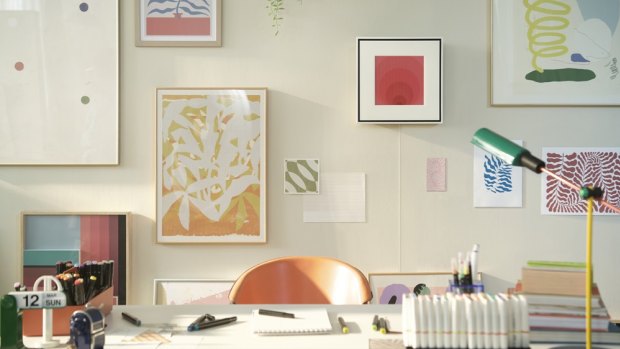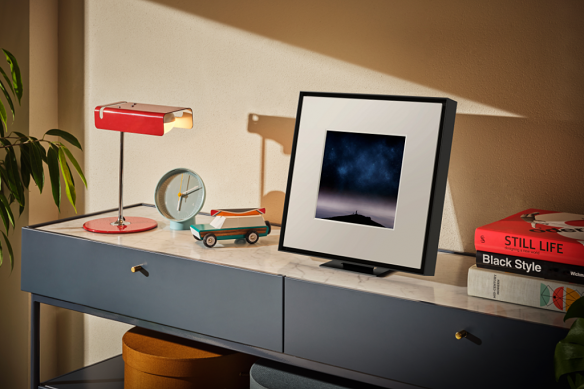- Review
- Technology
- Home tech
Picturesque smart speaker gives good sound with no tech clutter
By Tim Biggs
Samsung’s new Music Frame is a fully-featured smart speaker masquerading as a square block-mounted picture that you can put on your wall or sit on a stand, to add unassuming sound to your space with no bulky speaker required.
It’s a bit of a strange concept, but not one that comes out of nowhere. Samsung has had a lot of success with its Frame TVs, which can look like an art canvas when not in use, so it clearly imagines a consumer who doesn’t want any gaudy hi-fi or electronics tarnishing the aesthetic of their home.
However, putting decent sound capabilities into a skinny frame is a trickier feat than making a flat TV, especially when it’s designed to sit directly against a wall, in direct defiance of all sensible home speaker practices.
The $750 Music Frame crams six speakers in a two-channel configuration into a body that’s only around five centimetres deep, and slaps an acrylic art panel on the front, which sounds like a recipe for aural disaster. Miraculously, it’s not.

The Music Frame will fill a room with sound, without drawing attention to itself.
An invisible speaker
Given all the tech inside, the “art” part of the Music Frame is humorously low-fi. You pull off the acrylic panel, which is attached with a few plastic pegs, and inside is an 8x10-inch piece of paper with a picture of a turntable on it. You can take this out and replace it with any picture or photo you like, and the result looks just like a bulky picture frame with a huge white border. It should be noted though that while the internal clip holds an 8x10-inch (which is around 20x25 centimetres), the actually viewable area is a bit less than 19x19 centimetres, so some of the image will be cropped.
With a family photo inside the frame, most people wouldn’t immediately assume it is a speaker at all. To really customise it and get rid of that white border, you can order a replacement acrylic panel with any picture printed on it, but it’s going to cost you about $70.
The Music Frame comes with everything you need to either sit it on a stand or mount it to a wall, but the latter could get tricky, considering the need to hide cables. The device smartly has a thin, clear cord running from its back to a bulkier black adaptor, so you could either run it along the wall or drill a hole to drop it inside. Putting it on a shelf or buffet is probably easier.

On the included stand the Frame looks a bit more gadgety, but can hold any artwork or photo.
Connectivity-wise, the Music Frame is impressively comprehensive. It supports Chromecast, AirPlay and Spotify Connect – for getting music from your phone to the speaker over Wi-Fi – and it has Amazon’s Alexa built-in if you’d prefer to speak to it out loud. It does not have Google Assistant built in, but you can set any other assistant device to play on the Frame by default, which is a fair solution. If all else fails, there is also Bluetooth, and an optical port for a wired connection.
As a stand-alone music speaker, it sounds good and can become extremely loud, though you could get much richer audio for $750 with a more traditional speaker.
Sound seems to move out in all directions, so it will fill a good-sized room while making it tough to pinpoint where the sound is coming from, which seems to be the end goal.
However, even with Samsung’s SpaceFit technology, which it claims scans the surroundings to customise the EQ, the Music Frame overall sounds a bit thin when you’re not standing right next to it. Bass, after all, needs some room to breathe, and there’s only so much the Frame can do with its ports right up against a wall. That said, it did exceed my sonic expectations of a speaker shaped like a picture frame, and when you combine the Music Frame with other Samsung devices it can serve some other purposes too.
Seamless surrounds
Most obviously, pairing two Music Frames enables you to get much more effective (and costly) stereo sound and a bit more punch, and they’ll still look fairly unobtrusive sitting on your wall.
The speakers technically support Dolby Atmos content for spatial music, but the effect didn’t really come through with one speaker and was noticeable but not incredible with two.

Paired with a Samsung Frame TV, you could have your entire home theatre setup disguised on the wall.
One or two Music Frames can also connect to a Samsung TV via Wi-Fi and act as external speakers. I tested them with a Samsung OLED and the sound from the Music Frame was far superior to the TV’s built-in speakers. If you have a Samsung Frame TV you could mount all three units on the wall, for a TV and sound setup that looks like a series of art pieces.
Alternatively, you could pop a Music Frame next to your couch, and move the sound from the TV when you don’t need it booming across the room.
The speaker supports the same voice amplifier tech as Samsung’s soundbars, meaning it will try to boost the volume of dialogue when it detects your room’s ambient volume rising from something like a coffee machine or dishwasher.
If you have one of the latest Samsung TVs, you can also set a Music Frame pair up with Q-Symphony, which lets multiple speakers work together. So, for example, the TV speakers would still be active, and the Music Frames could become front or rear speakers. Add a Samsung soundbar and the Music Frames could go on the wall behind your couch for a surround effect that doesn’t require bulky rear speakers on stands. Currently, this only works with 2024 Samsung TVs and soundbars, so I wasn’t able to test it.
I have been impressed with Q-Symphony previously using soundbars and the TV speakers, and I’m sure the Frames would make for competent rears in standard 5.1, but I wonder whether they could produce enough height for convincing Dolby Atmos movie mixes.
Overall, while the sound from the Music Frame doesn’t quite stack up to other high-end smart speakers, or similarly priced bookshelf units, its shape and functionality makes a comparison to something like the bulky Sonos Era 300 a bit pointless.
Like the Frame TV, Samsung’s speakers are designed with decor in mind, and could go up solo in an office or as a pair in a loungeroom, to provide audio functionality that doesn’t take away from the effect of a curated art-filled space.
Get news and reviews on technology, gadgets and gaming in our Technology newsletter every Friday. Sign up here.